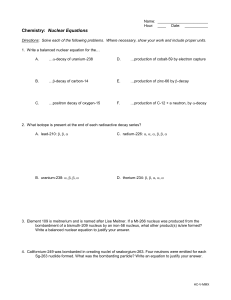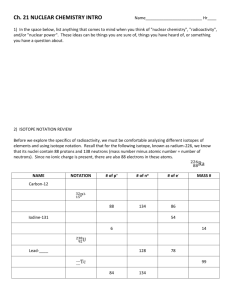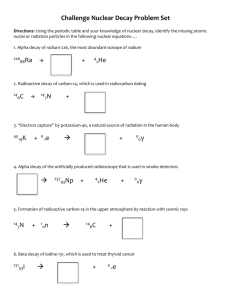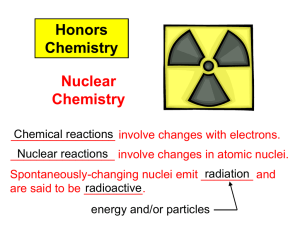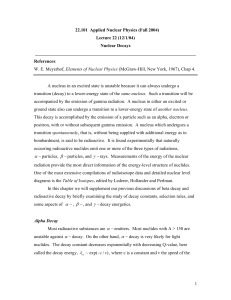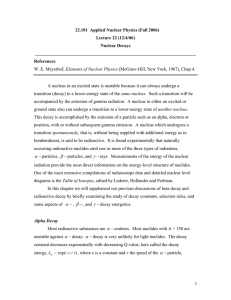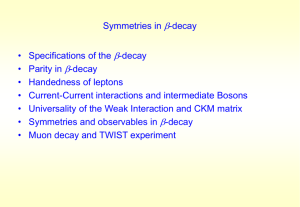Study Guide for Exam #3, Ch. 19-21
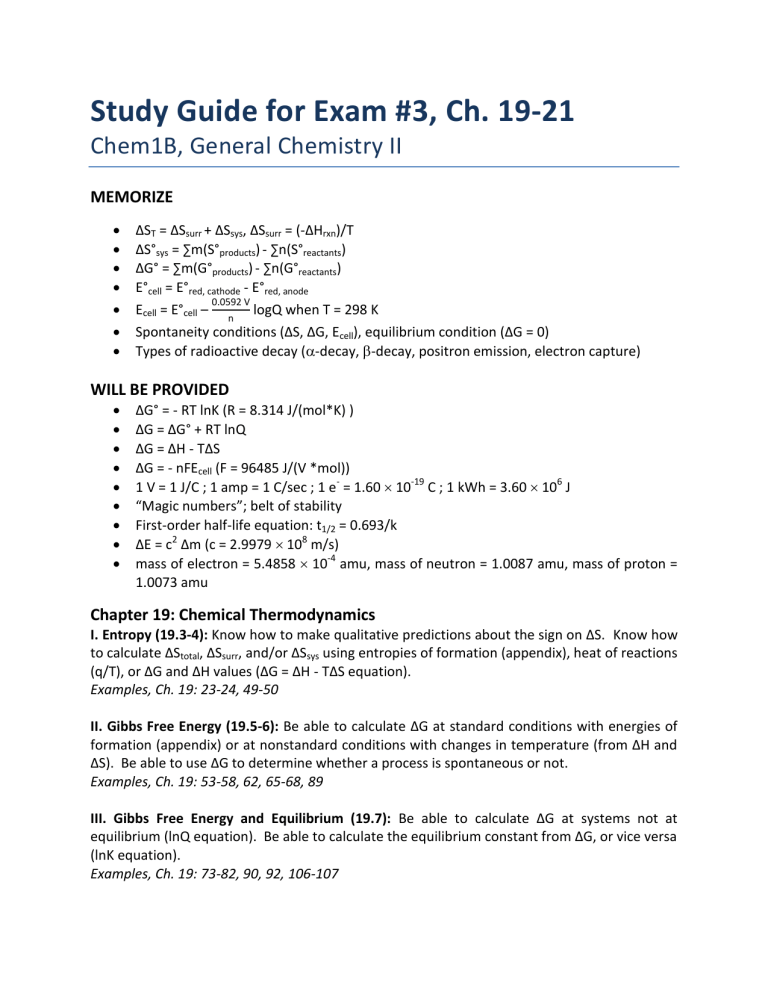
Study Guide for Exam #3, Ch. 19-21
Chem1B, General Chemistry II
MEMORIZE
∆S
T
∆S°
= ∆S surr
+ ∆S sys
, ∆S surr
= (-∆H rxn
)/T sys
= ∑m(S°
∆G° = ∑m(G° products
E° cell
= E° products red, cathode
)
) - ∑n(G° reactants
)
- E°
- ∑n(S° reactants red, anode
)
E cell
= E° cell
– logQ when T = 298 K n
Spontaneity conditions (∆S, ∆G, E cell
), equilibrium condition (∆G = )
Types of radioactive decay ( -decay, -decay, positron emission, electron capture)
WILL BE PROVIDED
∆G° = - RT lnK (R = 8.314 J/(mol*K) )
∆G = ∆G° + RT lnQ
∆G = ∆H - T∆S
∆G = - nFE cell
(F = 96485 J/(V *mol))
1 V = 1 J/C ; 1 amp = 1 C/sec ; 1 e
-
= 1.60
10
-19
C ; 1 kWh = 3.60
10
6
J
“Magic numbers”; belt of stability
First-order half-life equation: t
1/2
= 0.693/k
∆E = c
2
∆m (c = 2.9979
10
8
m/s)
mass of electron = 5.4858 10 -4 amu, mass of neutron = 1.0087 amu, mass of proton =
1.0073 amu
Chapter 19: Chemical Thermodynamics
I. Entropy (19.3-4): Know how to make qualitative predictions about the sign on ∆S Know how to calculate ∆S total
, ∆S surr
, and/or ∆S sys
using entropies of formation (appendix), heat of reactions
(q/T), or ∆G and ∆H values (∆G = ∆H - T∆S equation)
Examples, Ch. 19: 23-24, 49-50
II. Gibbs Free Energy (19.5-6): Be able to calculate ∆G at standard conditions with energies of formation (appendix) or at nonstandard conditions with changes in temperature (from ∆H and
∆S). Be able to use ∆G to determine whether a process is spontaneous or not
Examples, Ch. 19: 53-58, 62, 65-68, 89
III. Gibbs Free Energy and Equilibrium (19.7): Be able to calculate ∆G at systems not at equilibrium (lnQ equation) Be able to calculate the equilibrium constant from ∆G, or vice versa
(lnK equation).
Examples, Ch. 19: 73-82, 90, 92, 106-107
Chapter 20: Electrochemistry
I. Oxidation-Reduction (Redox) Reactions (20.1-2): Be able to identify what elements are being oxidized and which are reduced in a redox reaction. Know how to balance redox reactions in aqueous solution in both acidic and basic conditions.
Examples, Ch. 20: 15-16, 21-22, 93
II. Voltaic Cells (20.3): When given two half-reactions, be able to determine the anode and the cathode and what half-reactions will be occurring at each. Be able to balance the overall net redox reaction. Be able to identify in which directions e
-
will move and to which side the ions in the salt bridge will e attracted.
Examples, Ch. 20: 25-26, 33-36, 39-40, 59-60.
III. Standard Cell Potential (20.4-5): When given reduction potentials, know how to identify the cathode and anode to determine the overall potential for the cell (E° cell
) in standard conditions.
Know how to calculate ∆G° from E° cell
, or vice versa, and go on to calculate K eq
. Be able to use either E° cell
or ∆G to determine whether the process is spontaneous
Examples, Ch. 20: 49-56, 96, 102, 103, 111, 115
IV. Nonstandard Conditions (20.6): Know how to use the Nernst equation to solve for E cell and/or Q and/or the concentrations of species in the system at nonstandard conditions. Know how to use the Nernst equation to solve for E cell
and/or Q and/or concentrations of species in a concentration cell (when E° cell
= 0), and relate this back to K sp
.
Examples, Ch. 20: 61-65, 67-68, 99, 114
V. Electrolysis (20.9): Know how to use the applied amperage and time applied to solve for grams of metal produced via electrolysis, or vice versa.
Examples, Ch. 20: 87-88, 91-92, 107
Chapter 21: Nuclear Chemistry
I. Nuclear Equations (21.1-3): Know how to write balanced nuclear equations and identify the type of radioactive decay ( -decay, -decay, positron emission, or electron capture). Be able to use the belt of stability in order to determine what type of radioactive decay the nuclei is most likely to undergo. Know how to balance nuclear reactions for nuclear transmutations (collisions with neutrons or other nuclei).
Examples, Ch. 21: 11-14, 17-19, 27-30, 65, 68-69
II. Rates of Decay (21.4): Know the half-life equation for radioactive decay (first order reaction) and be able to use it to convert between amount and time, or vice versa.
Examples, Ch. 21: 33-34, 36-42, 72
III. Energy Changes (21.6): Know how to calculate the energy change for a nuclear reaction using ∆E = c
2
∆m. Be able to calculate the binding energy for a nucleus.
Examples, Ch. 21: 43, 46-50, 77

